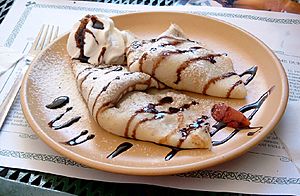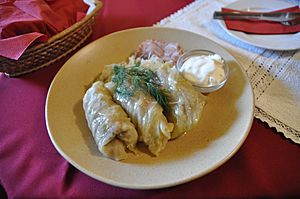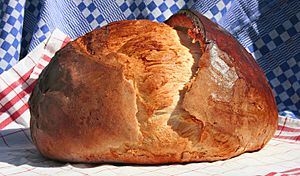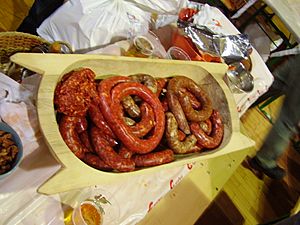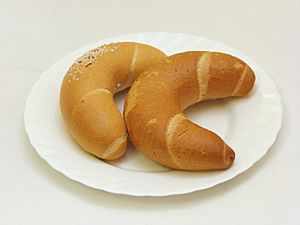Hungarian cuisine facts for kids
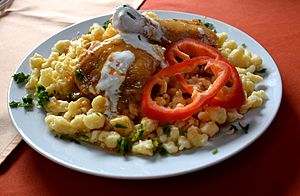
Hungarian cuisine (also called Magyar cuisine) is the special way of cooking and eating in Hungary. It's known for using lots of meat, fresh vegetables, fruits, bread, and dairy products.
Contents
What makes Hungarian food special?
Hungarian food is mostly like other foods in Central Europe. But it also has some unique touches from Eastern Europe, like using poppy seeds and popular dairy products like kefir and quark.
The magic of paprika
When you think of Hungary, you often think of Paprika! This spice is used a lot in many Hungarian dishes. Even though some people think Hungarian food is very spicy, most dishes actually use sweet (mild) paprika. Hot chili peppers are usually added on the side if you want extra spice.
Meat, bread, and sides
Hungarian food often uses a lot of dairy, cheese, and meats, similar to its neighbors like the Czech Republic and Slovakia. Chicken, pork, and beef are common. Other meats like turkey, duck, lamb, fish, and game are usually saved for special days. Hungary is also famous for its tasty and affordable salamis and sausages, mostly made from pork.
Bread is super important in Hungary. People eat it with almost every meal! In the past, white bread was the main type, but now you can find many different kinds of baked goods, like buns and pastries, both salty and sweet.
Most main dishes in Hungary come with a side dish. This is usually potatoes cooked in different ways, but rice or steamed vegetables are also popular. For example, csirkepaprikás (chicken paprikash) is almost always eaten with small dumplings called nokedli. Some dishes, like töltött káposzta (stuffed cabbage), are often served with sour cream and bread.
Famous Hungarian dishes
You might think Goulash is eaten all the time, but it's actually not an everyday meal! Other famous Hungarian meat stews include paprikás, which is a thick stew with meat in a creamy, paprika-flavored sauce, and pörkölt, a stew with boneless meat (often beef or pork), onion, and sweet paprika powder. Both are served with small dumplings called nokedli or galuska.
Hungarian cuisine is also known for its delicious soups, casseroles, desserts, and stuffed crêpes called palacsinta. There are even friendly competitions between regions about how to cook the same dish! For example, the hot fish soup called halászlé is made differently depending on whether you're near the Danube or the Tisza river.
Two unique Hungarian foods are vegetable stews called főzelék and cold fruit soups, like cold sour cherry soup.
Cheeses and smoked meats
Hungarians use many kinds of cheeses. The most common are túró (a crumbly quark cheese), cream cheeses, and a spicy sheep's milk cheese called juhtúró. Other popular Hungarian cheeses include Karaván, Pannónia, Pálpusztai, Emmentaler, Edam, and Trappista.
Smoked pork products are also very important. Many dishes get their special taste from smoked sausages, smoked ham, or smoked lard. These are also eaten on their own with bread and fresh vegetables, often for breakfast or dinner.
Pickled vegetables
Pickled (fermented) vegetables are often eaten, especially in winter. The most common is savanyú káposzta (sour cabbage, like sauerkraut), and pickled peppers and gherkins. A mix of cauliflower, green tomatoes, and even baby watermelons is also popular. These were a main source of vitamin C during the cold months. Some hearty dishes, like töltött káposzta (stuffed cabbage), use savanyú káposzta.
A look back at Hungarian food history
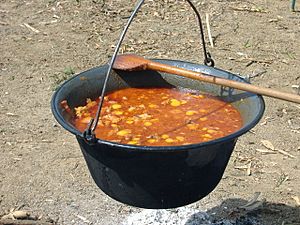
The history of Hungarian food is closely linked to the history of the Magyar people. Because the Magyars used to be nomadic (meaning they moved around a lot) and raised many animals, meat is a big part of their food. Traditional meat dishes like goulash (meaning "cattleman's meal"), pörkölt stew, and spicy fisherman's soup (halászlé) were all traditionally cooked over an open fire in a bogrács (a special cauldron).
In the 1400s, King Matthias Corvinus and his wife Beatrice from Naples brought new ingredients and spices to Hungary. These included sweet chestnuts, garlic, ginger, saffron, and nutmeg. Some of these spices, like ginger and saffron, are not used as much in Hungarian cooking today.
Over time, many different groups of people, like Germans, Italians, and Jews, settled in Hungary. They also brought their own dishes and cooking methods, which added to Hungarian cuisine. Hungarian food was also influenced by Austrian cuisine because of the Austro-Hungarian Empire. Many cakes and sweets in Hungary show this strong German-Austrian influence.
Today, Hungarian cuisine is a mix of its original Magyar traditions combined with influences from West Slavic, Balkan, Austrian, and German cooking. It's truly a "melting pot" of flavors from across Europe!
Hungarian meal times
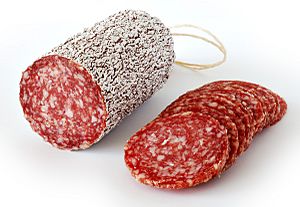
In Hungary, people usually eat a big breakfast. A typical Hungarian breakfast is an open sandwich with bread or toast, butter, cheese, or different cream cheeses. You might also find túró cheese or körözött (a spicy cheese spread), cold meats like ham, liver pâté, bacon, salami, or different Hungarian sausages. When they are in season, fresh tomatoes, green peppers, and cucumbers are often served with breakfast. Eggs (fried, scrambled, or boiled) can also be part of the meal.
However, many Hungarians today have a lighter breakfast. This might be a cup of milk, tea, or coffee with pastries, a bun, a kifli (crescent-shaped bread), or a strudel with jam or honey. Children might have rice pudding or semolina cream with cocoa powder or fruit syrup. Hot drinks are popular for breakfast.
Villásreggeli, or brunch, is a fancy, big breakfast for special occasions or holidays. It can include deviled eggs, cold meats, salads, pancakes, caviar, foie gras, fruit salads, and various pastries and cakes.
Lunch is the most important meal of the day. Traditionally, it has several courses, but nowadays, it's often just one main dish. Sometimes, cold or hot appetizers are served first, followed by soup. The main dish usually includes meat, a side dish, and a salad or pickled vegetables. Dessert or fruit might follow. In Hungary, pancakes can be a main dish or a dessert, but not usually for breakfast. Salads are often simple, like sliced cucumber or tomato in vinaigrette.
Some people and children have a light snack in the afternoon called uzsonna. This is usually an open sandwich, pastry, a slice of cake, or fruit.
Dinner is usually lighter than lunch. It might be a smaller version of lunch, or it could be like a traditional Hungarian breakfast with bread, cold cuts, cheeses, tomatoes, and peppers. If it's a special occasion, dinner can be as big as lunch. Otherwise, it's a good time to eat leftovers.
Hungarian meal times are flexible, but generally: Breakfast is from 6-9 am; Lunch from 12 noon-2 pm; Dinner from 6-9 pm.
Food for special days
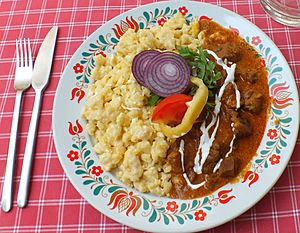
For Christmas, Hungarians often eat a fish soup called halászlé. Other dishes might include roast goose, roast turkey, or roast duck, and cabbage rolls (töltött káposzta). A pastry roll filled with walnut or poppy seeds, called (bejgli), is a common Christmas treat. Candies called szaloncukor are used to decorate the Christmas tree and are eaten right off the tree! Some families also eat lentil stew for good luck and health in the new year.
On New Year's Eve (Szilveszter), Hungarians celebrate with virsli (Vienna sausage) and lentil soup. On New Year's Day, it's common to eat either lentil soup or korhelyleves, a meaty sauerkraut soup.
Easter (Húsvét) is a very important celebration in Hungary. Families and friends gather, and women and girls prepare meals like smoked ham with boiled eggs and small sandwiches. Men and boys visit, recite a poem (Husveti Vers), and spray perfume on the women's hair (called Locsolkodas). After this, they share a meal and drinks before visiting the next family. In Szabolcs County, they make a special sweet yellow cheese called Sárgatúró from túró (quark) and eggs.
Popular Hungarian dishes

Soups
| Name | Image | What it is |
|---|---|---|
| Gulyásleves |  |
A hearty Goulash soup. It can also be cooked as a stew. |
| Halászlé | 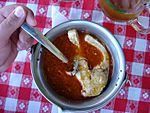 |
A famous hot and spicy fish soup with paprika. It's made with local freshwater fish, and different regions have their own special recipes. |
| Húsleves | 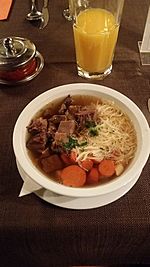 |
A slow-cooked broth, usually made with beef or hen, and lots of vegetables. It's often served with different kinds of noodles or small dumplings. |
| Gyümölcsleves |  |
A chilled, sweet soup made with redcurrants, blackberries, sour cherries, apples, or other seasonal fruits. It's often thickened with cream and served cold. |
| Meggyleves |  |
A popular version of fruit soup, made only with sour cherries. |
| Jókai-bableves | 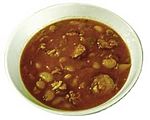 |
A rich bean soup with many vegetables, smoked pork, and noodles. It's often spicy and served with sour cream and white bread. |
| Csontleves | 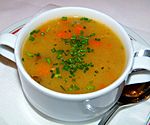 |
A basic bone broth, usually served with spaghetti noodles, carrots, and turnips. |
| Gombaleves |  |
A soup made from various wild mushrooms, often with sour cream. |
| Palócleves |  |
Similar to goulash, but lighter in color, a bit sourer (because of sour cream), and with dill. |
| Zöldségleves | 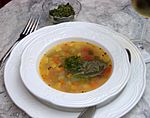 |
A soup with vegetables like peas, carrots, turnips, and parsley. |
| Sóskaleves |  |
Made from sorrel leaves in a broth, often with boiled eggs. It's thicker than some other soups. |
| Krumplileves |  |
Made from potatoes in a broth, often with sausage slices, carrots, turnips, or sour cream. |
| Pacalleves | 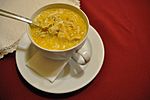 |
A tripe soup mostly eaten by Hungarians in Transylvania. It's usually seasoned with vinegar, sour cream, and garlic. |
| Borleves | A sweet wine soup, usually with cinnamon, raisins, and whipped egg whites on top. | |
| Köménymagleves | A simple soup made from caraway seeds, often with pieces of stale bread. | |
| Tojásleves |  |
Similar to köménymagleves, but with scrambled eggs added. |
Main courses
| Name | Image | What it is |
|---|---|---|
| Csirkepaprikás | 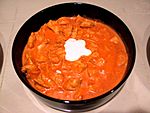 |
A chicken stew with lots of sweet paprika and cream or sour cream (tejföl). |
| Paprikás krumpli |  |
A stew like csirkepaprikás, but with potatoes instead of chicken, and often spicy sausage (kolbász). |
| Császármorzsa |  |
Shredded, sweet pancake pieces sprinkled with sugar. Often served with jam (like apricot or peach). It comes from Austria-Hungary. |
| Főzelék | 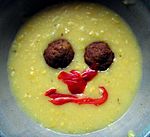 |
A thinner vegetable stew, almost like a thick soup. It can be made with many vegetables like cabbage, potatoes, spinach, or lentils. Meatballs or a fried egg can be added. |
| Lecsó | 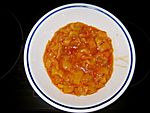 |
A mixed vegetable stew made mostly of tomato and paprika. It's similar to ratatouille but without squash. A version with scrambled eggs is called tojásos lecsó. |
| Székelygulyás | 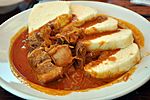 |
A hearty pork and sauerkraut stew, often flavored with paprika, onion, and sour cream. |
| Fasírozott | 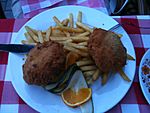 |
Flat, pan-fried meatballs made from minced meat (usually pork, veal, or beef) with paprika and salt. Often eaten with főzelék or served with rice or french fries. |
| Stefánia szelet | 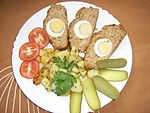 |
Hungarian meatloaf with hard-boiled eggs in the middle, which make pretty rings when sliced. Often served with potatoes. |
| Pörkölt |  |
A stew similar to ragù, made with boneless meat (veal, pork, chicken, beef, lamb), sweet paprika, and onions. Many versions exist. |
| Palacsinta |  |
A stuffed crêpe, usually filled with jam. Other fillings include sweet quark cheese with raisins, Nutella, or meat. |
| Gundel palacsinta | 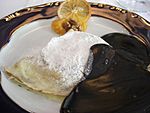 |
Named after Hungarian restaurateur Károly Gundel. These crêpes are stuffed with walnuts and served in chocolate sauce, often set on fire (flambéed) with rum. |
| Hortobágyi palacsinta | 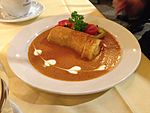 |
A thin savory pancake filled and covered with a meat stew, usually made from veal, onions, and spices. Often topped with sour cream. |
| Liptai túró | 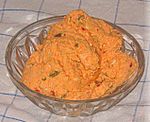 |
A spicy cheese spread with paprika, caraway, and onions. |
| Rántott sajt | 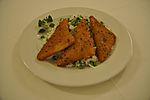 |
A flat cheese croquette; cheese rolled in breadcrumbs and deep-fried. Often served with french fries, mashed potatoes, or rice with peas (rizi-bizi). |
| Rántott hús | 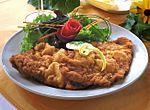 |
Originally from Austria. Meat that is tenderized, covered in eggs, flour, and breadcrumbs, then fried. Also known as Wiener schnitzel. |
| Rántott csirke | 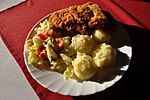 |
A chicken breast rolled in breadcrumbs and deep-fried, similar to Wiener Schnitzel. |
| Rakott krumpli |  |
A potato casserole made with eggs, paprika, spicy sausage, thick bacon, quark cheese (túró), onions, sour cream, or breadcrumbs. |
| Rakott káposzta | A layered cabbage dish with cabbage, pörkölt (stew), rice, sour cream, and spices. It comes from Hungarians in Transylvania. | |
| Sólet |  |
A Jewish-Hungarian stew with kidney beans, barley, onions, paprika, and sometimes meat and eggs. It's similar to cholent. |
| Szilvásgombóc |  |
Sweet plum dumplings, rolled in sweet, fried, buttered breadcrumbs. |
| Túrógombóc | 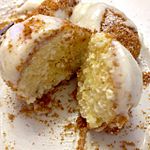 |
Sweet quark cheese (túró) dumplings without a filling, usually served with sour cream and icing sugar. |
| Töltött káposzta |  |
A cabbage roll made from pickled cabbage, filled with minced pork and rice. It can be served in tomato sauce with sour cream. It's popular around Christmas and New Year's. |
| Töltött tojás |  |
Stuffed egg or casino egg. Deviled eggs served cold (with mayonnaise) or warm (baked with sour cream), often with parsley or paprika. |
| Töltött paprika |  |
Stuffed peppers filled with pork mince and rice, served in a tomato sauce with salty boiled potatoes. |
| Pecsenye | 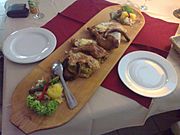 |
A thin pork steak, often served with cabbage or as part of fatányéros (pictured), a mixed grill on a wooden platter. |
| Cigánypecsenye | 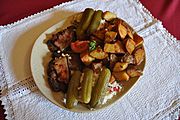 |
Literally "Gypsy roast." Fried or spit-roasted pork cutlets with thick bacon, spiced with paprika, salt, or pepper. Usually served with roasted potatoes or french fries. |
| Vesepecsenye |  |
Beef tenderloins, usually seasoned with paprika and salt. |
| Szűzpecsenye | 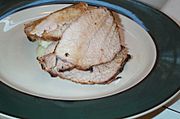 |
Literally "virgin roast." pork tenderloins, often prepared like vesepecsenye. |
| Brassói aprópecsenye | This dish is named after Brassó (now Brașov). It's made of diced pork and potatoes, pan-fried with onions, bacon, and seasoning. | |
| Mákos tészta | A very famous and common egg noodle dish made with ground and sweetened poppy seeds. | |
| Diós tészta | Boiled egg noodles served with ground walnuts and sugar, often with jam or honey. | |
| Gránátos kocka | A simple, home-cooked egg noodle dish with potatoes and paprika powder. Often served with pickled gherkins. | |
| Túrós csusza | 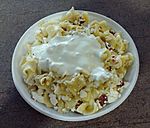 |
An egg noodle dish with quark cheese (túró), served savory (with bacon) or sweet (with sugar). |
| Vadas | Originally cooked with game meats like wild boar or deer, but often made with beef, veal, or rabbit. The meat is cooked in a vegetable sauce with carrots and other root vegetables. It's usually served with bread dumplings. | |
| Pásztortarhonya | 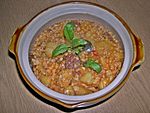 |
Literally "shepherd egg barley." A hearty dish with egg barley, potatoes, onion, kolbász (sausage), and paprika. |
| Tarhonyás hús | 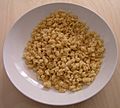 |
Egg barley with pieces of minced meat (usually pork), sometimes with potato and kolbász, and various spices. |
Sausages and cold cuts
- Hurka (boiled sausage, like liver sausage or black pudding)
- Téliszalámi (winter salami, a spiced, cold-smoked, and dry-aged salami)
- Herz Szalámi (another famous salami brand)
- Csabai szalámi and kolbász (spicy salami and smoked sausage from Békéscsaba)
- Gyulai kolbász (spicy sausage from Gyula)
- Debreceni kolbász (Debrecener sausage)
- Disznósajt (pig cheese, made from cooked pig's head meat, stuffed into a pig's stomach)
- Szalonna (Hungarian bacon, which has more fat than typical breakfast bacon)
- Virsli (a thin, Frankfurter-like sausage, eaten boiled with bread and mustard)
Sweets and cakes
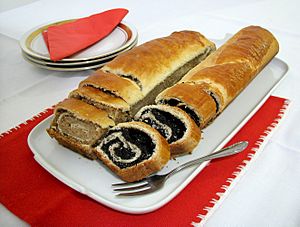
- Dobos Cake (sponge cake with chocolate paste layers and a caramel glaze, often with nuts)
- Linzer torta (a tart with a crisscross pastry design on top)
- Rigó Jancsi (cube-shaped sponge cake with dark chocolate glaze)
- Gesztenyepüré (cooked and mashed sweet chestnuts with sugar and rum, topped with whipped cream)
- Bejgli (cake roll eaten at Christmas and Easter)
- Kürtőskalács (Chimney cake, cooked over an open fire – a Transylvanian specialty and one of Hungary's oldest pastries)
- Csörögefánk (crispy, light Angel Wing fry cookies, dusted with powdered sugar)
- Vaníliás kifli (vanilla croissant, small, crescent-shaped biscuits)
- Piskóta (thin, light, sweet, crispy cookie)
- Rétes (layered pastry with a sweet filling)
- Csiga (literally snail – a rolled pastry with different fillings like walnut, poppy seed, chocolate, or vanilla pudding)
- Flódni (a cake with four different fillings: poppy seed, walnut, apple, and plum jam)
- Képviselő Fánk (Hungarian Cream Puff made from choux pastry and filled with vanilla cream)
- Kuglóf (a traditional Austro-Hungarian coffee cake)
- Lekváros Bukta (a baked dessert filled with jam, túró, or ground walnuts)
- Lekváros tekercs (rolled up soft sponge cake filled with jam)
- Lekvár (thick Hungarian jam)
- Birsalma sajt (Quince cheese, or quince jelly)
- Törökméz (a sweet, sticky white nougat paste with walnuts, spread between two wafer sheets)
- Madártej (Floating island, a dessert with milk custard and egg white dumplings floating on top)
- Túró Rudi (a chocolate bar filled with sweet quark cheese called túró)
- Szaloncukor (flavored candies that hang on the Christmas tree, eaten at Christmas)
- Arany galuska (dumplings or dough balls rolled in butter, sugar, and nuts, served with vanilla custard)
- Vargabéles (Hungarian strudel or Noodle Pie)
- Eszterházy torta (a cake with buttercream spiced with cognac or vanilla and walnuts)
- Somlói galuska (Somló-style Sponge Cake)
- Palacsinta (crêpe-like pancake)
- Mákos guba (a poppy seed dessert with sweetened kifli slices and poppy seeds boiled in milk)
- Túrós lepény or túrós pite (dessert bars made from sweetened túró; a version with dill is called kapros-túrós lepény)
Other popular foods

- Lángos (fried bread dough)
- Pogácsa (a type of bun, a round puffed pastry with bacon, often cooked over a fire)
- Zsemle (round small breads, eaten with butter, cold cuts, or jam, often for breakfast)
- Fánk or Bismarck Doughnuts
- Kifli (crescent-shaped bread. It can be plain, salted, or sweet)
- Perec (Pretzel, a salty crispy pastry)
- Májgaluska (small liver dumplings used in different soups)
- Grízgaluska (Hungarian boiled semolina dumplings used in soup)
- Tarhonya (a type of large Hungarian "couscous," served as a side dish or in Tarhonyás hús)
- Rizi-bizi (white rice cooked with green peas, served as a side dish)
- Vinetta or padlizsán krém (Transylvanian mashed eggplant salad)
- Körözött or Liptai túró (cheese spread with paprika and onions)
- Libamájpástétom (Hungarian delicacy: goose liver pâté)
- Bundás kenyér (literally "bread with a fur," a savory French toast or bread fritter, eaten for breakfast or as a side dish)
- Kenyér (Hungarian bread, often baked fresh daily. Cipó is big and round with a hard crust, while vekni is long like a baguette.)
- Kenyérlángos (a smaller piece of bread dough baked flat, often topped with sour cream, bacon, and onions; a traditional snack)
Hungarian drinks
Hungarian wine has a long history, going back to Roman times.
The most famous wines are the white dessert wine called Tokaji Aszú (from the Tokaj region) and the red wines from Villány. Another well-known wine is Bull's Blood (Egri Bikavér), a dark, full-bodied red wine. Hungarian fruit wines, like red-currant wine, are mild and soft.
Hungary's most famous strong drinks are Unicum, a herbal bitters, and Pálinka, which is a fruit brandy (plum and pear are popular flavors). There are also 21 brands of Hungarian mineral waters, like Apenta and Kékkúti. Some of these waters are even used for their health benefits!
Traubi or Traubisoda is a soft drink that has been made in Hungary since 1971. Before soft drinks were common, Hungarians made their own drinks called szörp. This is a sweet concentrate made from fruits like raspberry, currant, or elderberry, which is then mixed with water.
See also
 In Spanish: Gastronomía de Hungría para niños
In Spanish: Gastronomía de Hungría para niños




